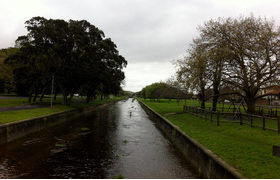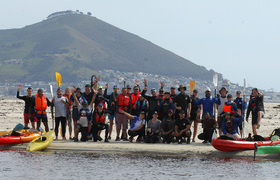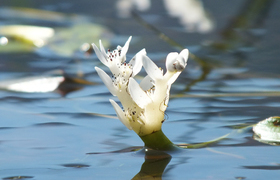Harvesting storm water from the Liesbeek River
26 November 2018 | Story Susan Segar. Read time 7 min.
Harvesting storm water from the Liesbeek River could offer a viable alternative to supplementing Cape Town’s precarious water supply, three University of Cape Town (UCT) Biological Sciences students have determined in their first-ever publication.
The paper, by Ruan van Mazijk, Lucy Smyth and Eleanor Weideman, resulted from an honours module run last year during the city’s “Day Zero” crisis and was published recently in the journal Water SA.
Examining the source of water in the Liesbeek River, the paper, “Isotopic tracing of storm water in the urban Liesbeek River”, supports studies which suggest that the river could, in future, be a target for storm-water harvesting.
The dedication of the three so impressed their lecturer, Associate Professor Adam West of the Department of Biological Sciences, that he suggested they write it up for their first publication – offering them excellent exposure to the scientific publication process.
Water SA, an open-access journal, is an in-house journal of the SA Water Resource Commission.
Using stable isotopes, the students showed that almost all the water in the Liesbeek River following a storm in a drought year was derived from recent rainfall, and was not displaced groundwater as had been found in a previous study from a natural catchment in the Jonkershoek area (Midgley & Scott 1994. The use of stable isotopes of water (D and 18O) in hydrological studies in the Jonkershoek Valley. Water SA 20(2):151-154).
West pointed out that this meant the rain water, “falling on a hardened urban environment and then subsequently running through a highly canalised urban river to the sea”, is effectively lost from the terrestrial system. It also doesn’t recharge the groundwater.
Remarkable outcome
“Thus, utilising this water in a storm-water capture project for aquifer recharge, or urban use, could benefit a water-stressed city, without negatively compromising our groundwater resources,” he explained.
Remarkably, the paper emerged from an only week-long module that took place during a rare storm in drought-stricken Cape Town last year. West had suggested to his students that they harness the rain for research purposes.
“The paper was a remarkable outcome for a week-long honours module,” he said.
“The three students on the paper were highly engaged and dedicated during 48 hours of continuous sampling. I think this is a remarkable lesson in what is achievable in science given a relevant question and passion. The knowledge frontier is often closer than we think.”
Lead author Van Mazijk said he was thrilled with the outcome of their research.
“We are two zoologists and a botanist (myself), and we didn’t think our first paper would be a hydrology paper. It’s very exciting.”
“It’s thrilling for all of us, but particularly thrilling for me to be first author. For all of us, it is our first paper. We are two zoologists and a botanist (myself), and we didn’t think our first paper would be a hydrology paper. It’s very exciting.”

Explaining West’s brief during that week of storms, Van Mazijk said his lecturer had seen the rain as an excellent opportunity to measure the Liesbeek River water.
“We collected rain water and took water samples from the river, and analysed their isotopic signatures. In the course of 48 hours, we were taking measurements every hour to two hours. We were out in the middle of the night and pouring rain taking samples, which was actually loads of fun,” he recalled, adding that they then analysed the data.
“We each wrote it up as individual reports for the module, and then Professor West thought it looked promising as we had genuine findings there. That was when he said: ‘Let’s see if we can get it published’.”
The abstract of the paper said that the ongoing drought since 2014 has sparked an urgent need to improve the understanding of water resources in the area.
“Rivers within the Western Cape are known to surge rapidly after rainfall events. Such storm flow in natural river catchments such as in the Jonkershoek mountains has previously been shown to be driven by displaced groundwater (ʻpiston-flowʼ), with less than 5% of rainfall appearing in the storm flow.
Storm-flow surges
“However, the origin of storm-flow surges within urban rivers in the region remains understudied.”
The authors said they used stable isotopes in water to illustrate that at least 90% of water in the Liesbeek River during a storm event was rainwater. Storm flow within this urban river therefore appeared to be driven by overland flow over the hardened urban catchment, rather than piston-flow as seen in natural catchments.
“Our results support suggestions that the Liesbeek River could be a target for storm-water harvesting to augment water resources in the city of Cape Town.”
Van Mazijk said that the trio did not propose any actual plans of how water from the river could be harvested, but that the information they supplied about how this single river behaved in the storm is “very useful information for storm-water capture scientists”.
He agreed with West that their success showed what UCT students are capable of, on all levels – and that “the unknown is not very far away”.
“It also demonstrates what can happen if you just encourage a few students. Professor West took our findings seriously. If you encourage a group of students and take the work seriously you can get genuine successes out of it,” he said.
This reflected the culture in the department of “turning student projects into something meaningful”.
“We didn’t reinvent the wheel but we got our findings out there. This paper adds to the body of literature that finds that urban rivers behave this way.”
They hope to see their study as a data point in a future review.
“This is not a solution to the drought. It’s one of the many things that can help,” said Van Mazijk.
Into the future, the self-proclaimed evolutionary biologist and botanist, who says he’s “bonkers” about plants, hopes to enter academia.
“I love academia – that combination of research, teaching, writing and analysis. I hope to do my PhD, but I don’t yet know where I will do that. Luckily, I have a whole year of my MSc to think about that.”
 This work is licensed under a Creative Commons Attribution-NoDerivatives 4.0 International License.
This work is licensed under a Creative Commons Attribution-NoDerivatives 4.0 International License.
Please view the republishing articles page for more information.
Cape Town water crisis
At UCT our researchers have been analysing the causes of the current drought, monitoring water usage on campus and in the city, and looking for ways to save water while there is still time. As part of UCT’s water-saving campaign, all members of the campus community are encouraged to reduce their water use by half, which will help Cape Town to meet its water-use goals and ensure a water-sustainable university in the future.



























